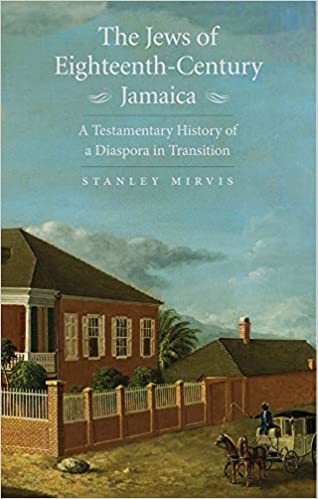Stanley Mirvis
THE JEWS OF EIGHTEENTH-CENTURY JAMAICA: A TESTAMENTARY HISTORY OF A DIASPORA IN TRANSITION
New Haven, CT: Yale University Press, 2020 ISBN: 978-030-023-881-5
Reviewed by Michael Rom1
Although the Jamaican Jewish community was the second largest in the eighteenth-century English-speaking world, Jamaican Jews have not received nearly as much historiographic attention as other colonial Caribbean Jewish communities in places such as Barbados, Curaçao, and Suriname. This neglect is due to the paucity of Jewish historical documentation from Jamaica, with all pre-twentieth-century communal records lost in the Kingston fire of 1882 and the 1907 earthquake that destroyed the city’s synagogues. One important type of historical source remains, however, in the form of over four hundred Jewish wills from what Stanley Mirvis calls “the long eighteenth century” (10), spanning from 1673 to 1815. These wills provide the primary documentary basis of his pathbreaking social history of Jamaican Jews, in addition to other meticulously assembled sources, including colonial government papers, correspondence with London Jewish communal institutions, naturalization records, newspapers, parliamentary debates, and tombstones. Using these expertly culled documents, Mirvis has produced an impressively nuanced, riveting account of an immigrant community in transition, one that includes both Ashkenazim and Sephardim, merchants and planters, and even one Jew who travelled on board a pirate ship, although it seems that he was merely along for the ride.
Mirvis’s study is divided into seven chapters, featuring four overlapping chronological chapters, and three thematic ones. Chapter one examines the formation of the Jamaican Jewish community during the second half of the seventeenth-century, tracing their origins to Jewish refugees from Dutch Brazil, Portuguese New Christians who returned to Judaism in Bayonne and Bordeaux in the south of France, and further migrants from Amsterdam, London, and the French Caribbean islands of Guadeloupe, Martinique, and Saint Domingue. These Jewish immigrants primarily settled in Port Royal, one of the most densely-populated urban spaces in the English Atlantic and a model of port-city ethnic and religious diversity, where Jews and other European religious minorities could trade freely, own land, and arbitrate their disputes in court by naturalization or the acquisition of a less expensive status known as “denization.” Jewish privileges were not unlimited, however, and did not allow Jews to vote, practice law, or run for electoral office, among other disadvantages. As the second chapter explores, anti-Jewish discrimination only increased following the destruction of much of Port Royal during the 1692 earthquake, which led to the institution of a collective tax on Jews the following year, and in the wake of the First Maroon War (1729-40), when Jews were accused of providing the rebels with gunpowder.
Although antisemitic Jamaican officials primarily targeted Jewish traders and believed Jews to be “averse to planting,” Mirvis notes that many Jamaican Jews owned and operated plantations, and that by the end of the eighteenth-century, Jamaica was home to the largest concentration of Jewish planters in the Caribbean. Chapter three considers the lives of several prominent Jewish planters, including the Gabay family, Jacob Henriques, and Benjamin Pereira. It also tackles the phenomenon of Jewish slave ownership, arguing that this significantly contributed to the evolution of Jewish Creole identity by bringing Jews into contact with creolized African cultures. Building on this chapter, the fourth chapter addresses a hodgepodge of topics related to the final decades of the “long eighteenth century” (1770-1815), including the place of Jews in colonial Jamaica’s racialized social hierarchy, the steady erosion of Jewish social status, prominent rabbis and physicians, the Ashkenazi Jewish community, and ongoing ties with France. His historical survey completed, Mirvis then turns to more thematic chapters. Chapter five explores the communal lives of men, women, and children, the sixth chapter examines the importance of endogamous marriage in perpetuating Portuguese ethnic identity, and chapter seven considers Jamaican Jewish males’ complicated relationships with their mistresses and children of color.
Mirvis’s treatment of the place of Jews in colonial Jamaican society is among the more provocative aspects of the book, especially in light of contemporary debates on Jews and whiteness, and is therefore worthy of further discussion. He claims that Jews “were neither White nor Black, neither enslaved nor entirely free” (90), and frequently contrasts Jews and “Whites,” a monolithic group that presumably excluded Jews. But while it was true that Jews did not enjoy all the same privileges as settlers of English Protestant origin, their civic and political disadvantages were also shared by Catholics, who, unlike Jews, Moravians, and Quakers, could not naturalize under the terms of the 1740 Plantation Act, placing Catholics below these groups within the colonial hierarchy. By integrating religion as a category of social difference into his analysis of racial stratification, Mirvis could have offered a more complex depiction of the social status of Jews and other religious minorities in the British Atlantic. Furthermore, an exploration of Jewish difference as a product of ethnicity in addition to race and religion would have enabled this work to enter into productive dialogue with recent historiographical scholarship on “White ethnics” in the Americas, which has shown whitening to be an uneven process, and putative racial binaries to be more accurately described as ethno-racial spectrums.
These minor concerns aside, Mirvis is to be commended for having produced a model social history of a heretofore almost entirely unexamined Jewish community, yet one that occupied a critical node within Atlantic and Caribbean Jewish networks. His accomplishment is all the more noteworthy when one considers the extent to which it relied upon a careful reading of the largely untapped historical resource of Jewish wills, excerpts of six of which are provided in the book’s appendix. One hopes that Mirvis’s work will inspire further research of a similarly high caliber on Jews in Jamaica, and within other neglected regions of the colonial Americas.
1 Michael Rom is the inaugural Postdoctoral Research Fellow at the Kaplan Centre for Jewish Studies at the University of Cape Town.
